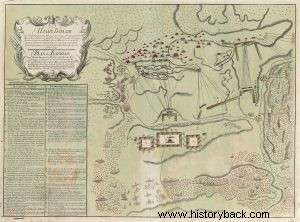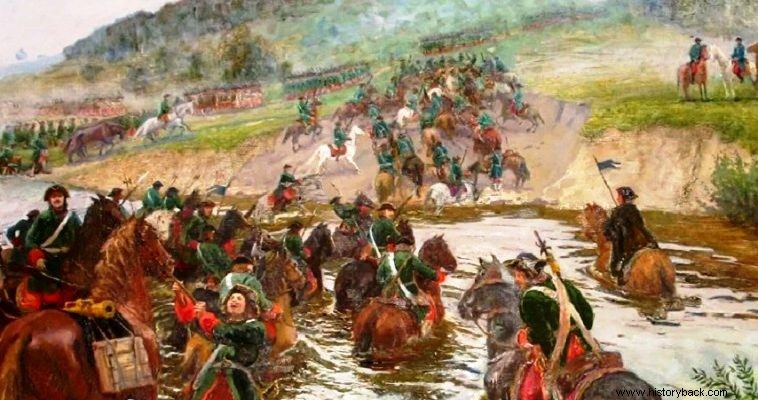
In 1735 the Crimean Tatars, allies of the Turks, made yet another devastating raid on the lands of the Russian Empire. This was the reason for the declaration of war by the Russians against the Tatars and Turks. In 1739 the war had passed through several stages. In 1739, the Russian army of the German marshal Buchhardt Christoph von Münch had reached the present-day Ukraine-Moldavia border. Minnich had 61,000 men (48,000 fighting men), 85 field guns and about 170 light (battalion guns) divided in twos between his infantry battalions in direct support.
Against him, the Turkish general Veli Pasha managed to gather, on the heights near the small village of Stavoutsani, 90,000 men, including 20,000 janissaries, an equal number of spachis, other auxiliary infantry and a large number of Tatar light cavalry. The Turks also had 70 large cannons.
Veli deployed his army to a strong defensive position on the heights while simultaneously sending his tens of thousands of Tatar horsemen to move on either side of the Russian army's axis of advance with the apparent intention of encircling it, if possible, or at worst inflicting casualties on them and disrupt it. In his main line of defense, Veli ordered the janissaries and his artillery in the center, with the spearmen and auxiliary bodies on the flanks of the janissaries.
The Turkish defensive position extended to a length of about 5.5 km and the density of its occupation was particularly important. The Turks created a truly fortified site, building 11 gun emplacements, a triple line of trenches and fortifying the village of Nebodovetsi. However, they had not had time to complete the work on the last 2,100 m of their front before the Russian army arrived in front of them.
The Russians are coming
The Russian army, moving in the form of a huge square, ignoring the threat of the Tatars, arrived on the afternoon of August 27, 1739 at the small Sulanets river, although surrounded by thousands of rival horsemen, as Veli decided to reinforce the Tatars with the braves of, leaving only the janissaries and artillery in the defensive location.
Minnich nevertheless continued. Approaching the Turkish location, he noticed that fortification work was still being carried out on its right. Minnich, a particularly remarkable soldier, although surrounded, decided that the best solution was to attack! According to the plan he drew up, a part of his army would carry out a deceptive attack against the Turkish right, while he himself with the bulk of the army would attack the strong Turkish left, that is, where the enemy did not expect an attack.
The deceptive attack was undertaken by the also German Lieutenant General Gustav von Biren with 9,000 men and 34 guns and howitzers. Early on the morning of August 28 the Russians were ready. Biren's force crossed the river and formed a large P with a front length of 560m. and sides of approximately 200 m. In front of his front he ordered his artillery keeping in reserve an artillery of howitzers.
The Turks immediately opened fire with their artillery, receiving in turn the Russians' fire. However, the said artillery duel, due to distance, was not particularly effective. Especially the Turkish gunners looked very inferior after 100 shots they managed to wound the horse of a Russian dragoon! However, Veli, seeing Biren's Russian strength, fell into Minnich's trap, believing that the Russian attack would be launched on his weak right flank. Thus he began to transfer forces from the left to the right. At the same time, Turkish cavalry under Kolchak Pasha made a flank attack on the force of Minnich who was waiting behind the river.
But the attack was repulsed and around noon, Minnich ordered their men to move to the right towards the river bank, ordering Biren to retreat as well. Veli, seeing Biren's force retreating, believed that the entire Russian army was on its feet and even hurried to send a message to Khotin that he had won! But he soon realized his mistake and began sending troops back to his left flank as the Russian army crossed the river and began massing for an attack against the Turkish left. Genge Ali Pasha's Tatars and Kolchak's Turkish cavalry Pasha again attempted to attack the Russians as they were crossing the river from a ford. However, they were repelled by the Russian fire.
The green wave comes out
Minnich ordered his forces into three large squares. On the right, the force of the German lieutenant general Karl von Biren was the first to cross the river by any means available, occupying nearby heights in order to widen the bridgehead and facilitate the passage of the rest of the Russian force. The Turkish cavalry launched furious attacks but achieved nothing against the Russian square.
By 16.00 the entire Russian army had crossed the river and was in front of the Turkish position. Minnich formed his army into a huge single square and prepared to attack. But the Turks caught up with him. Veli launched 13,000 janissaries against the Russians when the Russians reached the village of Stavoutsani. At the same time he ordered his cavalry to attack. The Russians greeted the Turks with heavy infantry and artillery fire.
The Turks were repulsed while the janissaries fled in disgrace. The Russians advanced and captured the Turkish position and all of Velis' guns. Now only the Turkish and Tartar cavalry remained on the field, trying desperately, but without effect, to intercept the Russians. Russian artillery fire soon forced them to flee as well.
Such panic prevailed that the Turks also abandoned Hotin without a fight. The losses of the Russians were extremely small – 13 dead and 54 wounded. On the contrary, the Turkish army was disbanded. Although the dead numbered a little over 1,000, the morale of the Turks and their allies was so low that Velis' army ceased to be an organized force.
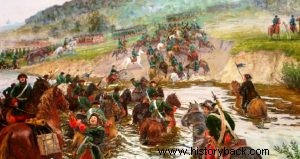
The Russian army crosses the river.
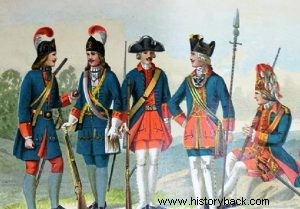
Russian grenadiers and musketeers.
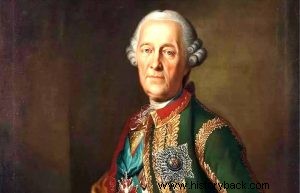
Marshal von Minnich.
